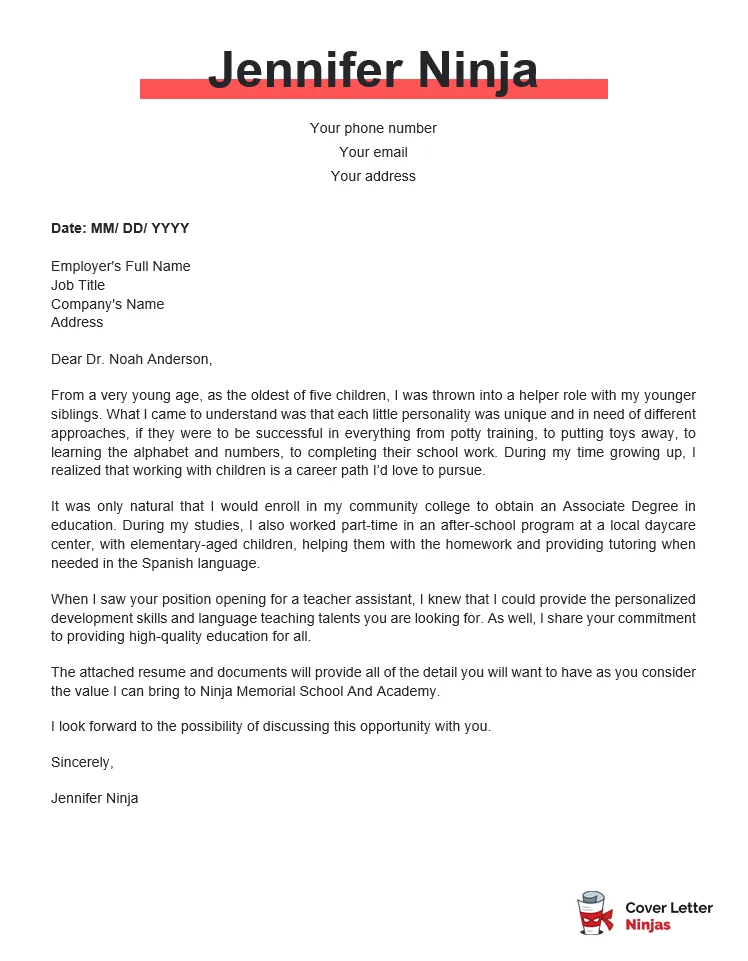Why a Great Cover Letter Matters for TAs
In the competitive landscape of academic job applications, a compelling cover letter can be the pivotal factor that distinguishes you from other candidates. For aspiring Teaching Assistants (TAs), a well-crafted cover letter serves as your initial introduction, offering a unique opportunity to showcase your personality, skills, and enthusiasm beyond the confines of a resume. It allows you to articulate your motivations, demonstrate your understanding of the role, and connect with the hiring committee on a more personal level. While a resume presents a factual overview of your qualifications, a cover letter provides the narrative—the story of why you are the ideal candidate for the teaching assistant position. It’s your chance to demonstrate genuine interest, highlight your relevant experiences, and effectively communicate how your skills align with the specific needs of the department and the professor. A strong cover letter not only increases your chances of securing an interview but also reflects your professionalism, attention to detail, and commitment to excellence.
Highlighting Your Skills
A successful TA cover letter goes beyond listing your skills; it actively demonstrates how you’ve utilized those skills in previous contexts. Prospective employers are looking for specific skills sets to ensure the smooth operation of the course and a positive learning environment for the students. Identifying the most crucial abilities and providing concise examples of your achievements will enable the reader to understand the value you offer in the role of a TA. This is a chance to describe how you have used these skills in a relevant context, whether during coursework, projects or volunteer activities.
Communication Skills

Effective communication is the cornerstone of a TA’s role, encompassing both written and verbal interactions. In your cover letter, highlight instances where you’ve successfully conveyed complex information in a clear and concise manner. For instance, describe your experience explaining challenging concepts to peers, providing constructive feedback on assignments, or mediating discussions in a classroom setting. Give real-life examples, such as assisting students with writing projects, or presenting complex information in a simpler format. Mention situations where you used different communication styles to connect with diverse audiences, such as adapting your communication style to meet the needs of different learning styles or cultural backgrounds. Emphasize your ability to actively listen, understand, and respond appropriately to student inquiries and concerns. (See image communication-skills-ta.webp)
Organization & Time Management
TAs must be adept at managing their time and organizing tasks efficiently to meet deadlines and support student success. Provide specific examples where you demonstrated organizational skills. This could involve managing multiple responsibilities, creating detailed lesson plans, coordinating group projects, or prioritizing tasks effectively. Showcase your ability to manage your time effectively. Highlight any experience you have with scheduling, and organizing resources. For instance, you might explain how you created a timeline for grading assignments, organized study sessions, or managed communication channels to keep students informed. (See image organization-skills-ta.webp)
Subject Matter Expertise
Showcase your expertise in the subject matter by providing examples of your academic achievements. Provide specific instances where you’ve excelled in relevant coursework, conducted research, or presented complex topics. If you’ve taken advanced courses or earned high grades in areas related to the TA position, explicitly mention them. If you’ve conducted research in the field, briefly describe your findings and how they relate to the course content. This may include examples of projects where you’ve demonstrated in-depth knowledge. Highlighting any publications or presentations, or special skills are useful in the role of a TA. (See image subject-matter-expertise-ta.webp)
Showcasing Your Experience
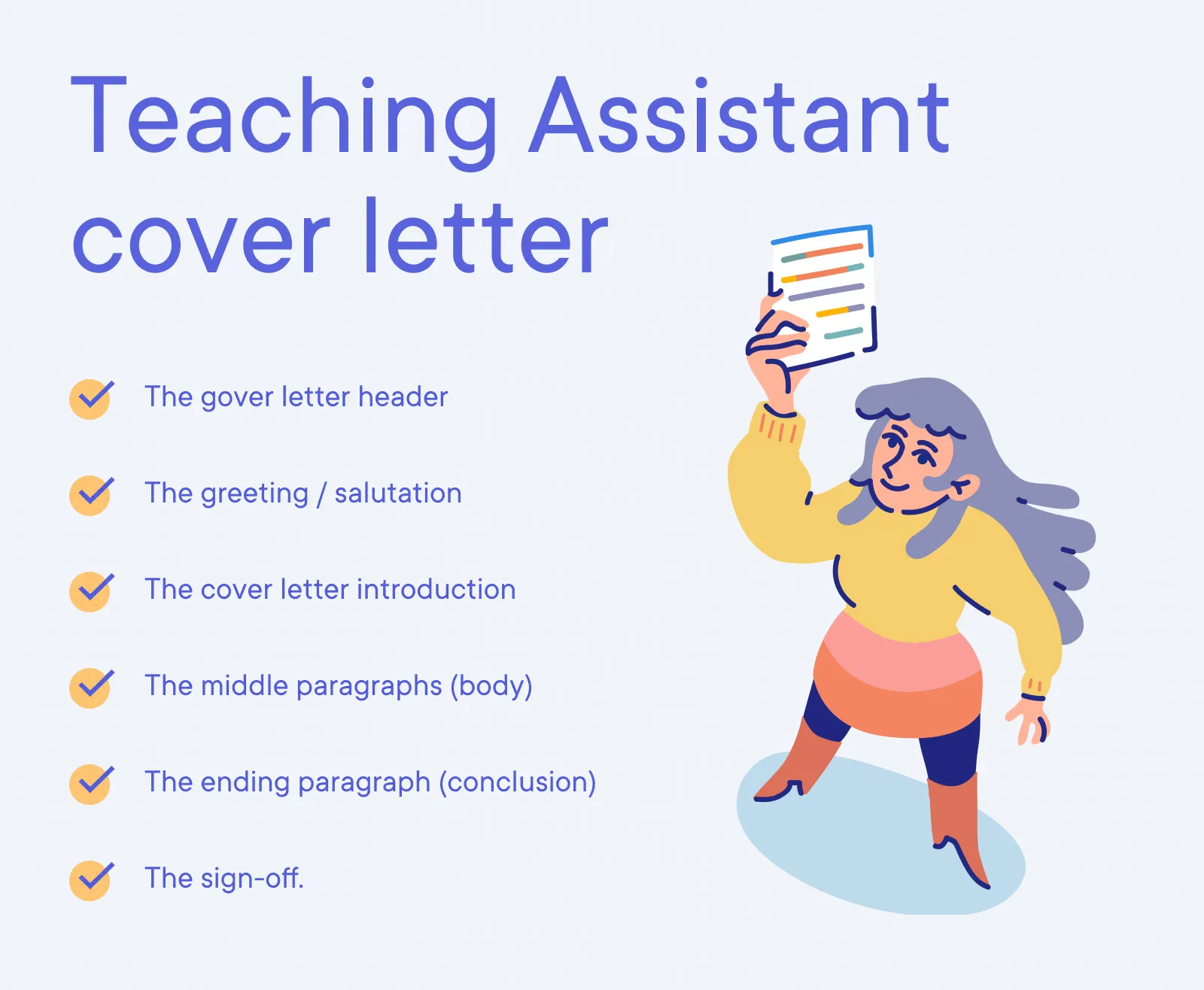
Beyond your skills, your experience is a tangible demonstration of your capabilities. In the cover letter, provide detailed accounts of your previous experiences. This could include previous roles as a TA, tutoring, or any experience in a teaching or educational environment. Present detailed examples of the responsibilities you held and the achievements you accomplished in these roles, focusing on how they align with the requirements of the TA position. When describing your experience, use the STAR method (Situation, Task, Action, Result) to provide context, and emphasize your contributions and the outcomes of your actions.
Relevant Coursework or Projects
Highlight any relevant coursework or projects that demonstrate your understanding of the subject matter and your ability to apply theoretical knowledge. If you have completed significant projects or research that aligns with the course, briefly describe them and explain the skills you used. If you’ve excelled in coursework that is directly relevant to the TA position, mention specific courses and your grades. Describe how these experiences have prepared you for the responsibilities of a TA, and how they have equipped you with the skills and knowledge necessary to support student learning effectively. This demonstrates your commitment to the field and your eagerness to contribute to the academic environment. (See image relevant-coursework-ta.webp)
Previous TA or Tutoring Roles
If you’ve held TA or tutoring roles previously, this section is crucial. Describe your responsibilities, achievements, and the skills you developed. Give specific examples of how you assisted students, managed classroom activities, or provided feedback on assignments. Quantify your achievements whenever possible, such as the number of students you supported or the improvements in student performance. If you received positive feedback from students or professors, include it here. Highlight any instances where you went above and beyond your duties, such as organizing extra study sessions or creating supplemental materials. Emphasize the transferable skills you have gained from your previous experience, such as communication, organization, and problem-solving.
Tailoring Your Cover Letter
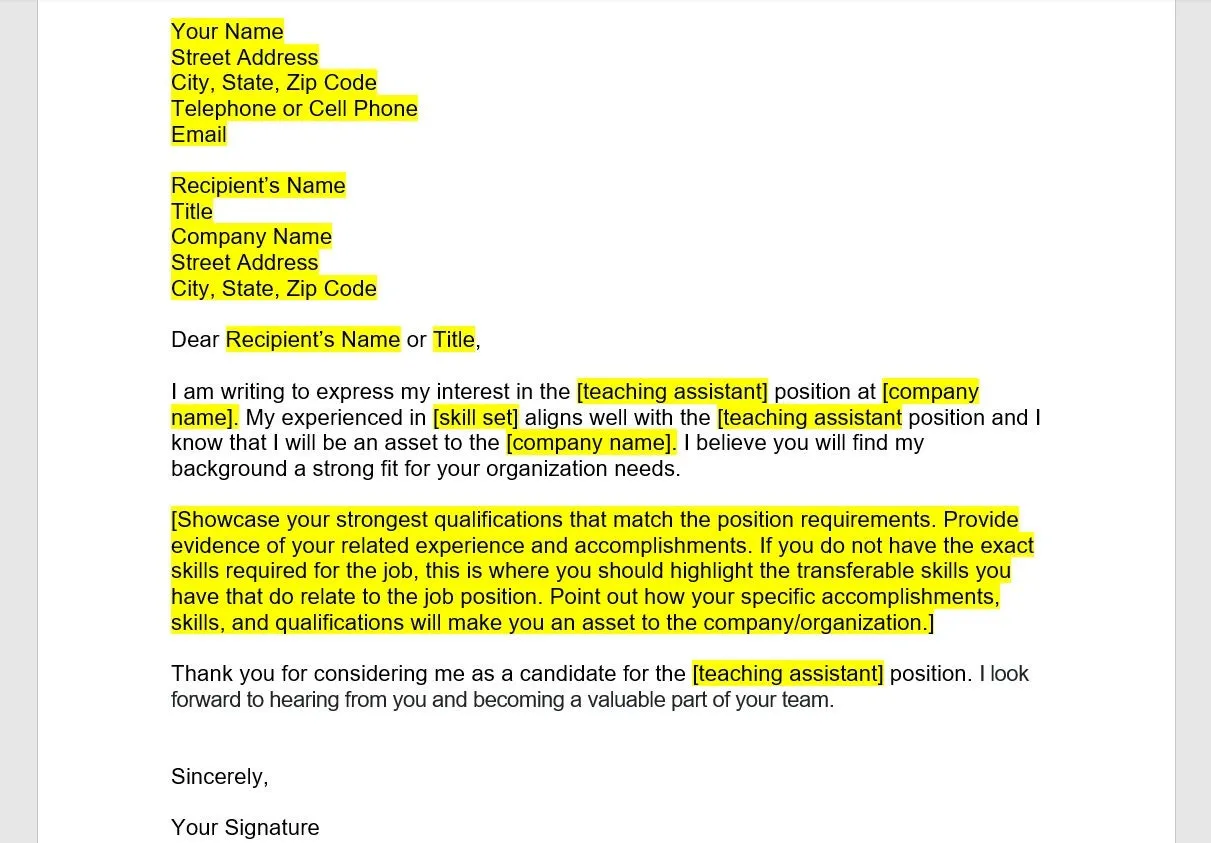
One of the most crucial elements of a successful cover letter is its ability to be tailored to the specific position and institution. A generic, one-size-fits-all cover letter will not impress hiring managers. Instead, your cover letter should demonstrate a genuine interest in the particular role and the department. By personalizing your letter, you show that you’ve taken the time to research the position, the professor, and the academic environment.
Researching the Department & Professor
Before writing your cover letter, thoroughly research the department, the professor you’ll be assisting, and the course itself. Visit the department’s website to understand its mission, values, and areas of focus. Review the professor’s research interests and publications to show that you understand their work. Mention any specific projects or research that resonate with your own interests or experience. This shows that you are genuinely interested in the position and have invested time and effort in understanding the needs of the department. Use the professor’s name correctly and personalize your letter by referencing their work or the course objectives.
Matching Skills to Job Requirements
Carefully read the job description and identify the key requirements, skills, and qualifications the hiring manager is looking for. Then, review your own skills, experience, and accomplishments and identify where they align with the requirements listed in the job description. Structure your cover letter to highlight these relevant skills and experiences. Use specific examples to show how you’ve demonstrated those skills in the past. Use keywords from the job description throughout your cover letter to demonstrate that you meet the specific needs of the position. By aligning your skills with the requirements, you show that you are the right fit for the role.
Cover Letter Structure & Format
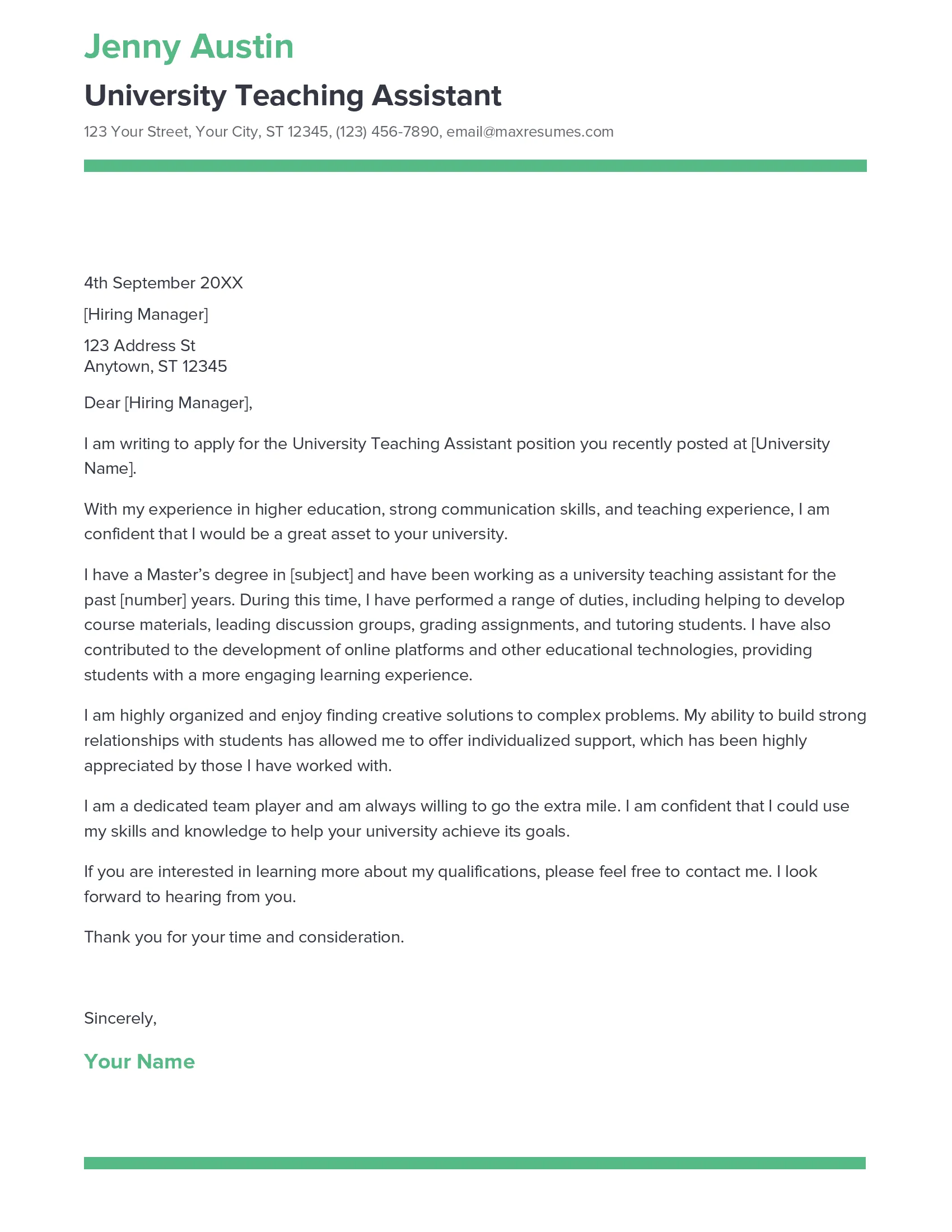
The structure and format of your cover letter are essential for creating a positive first impression. A well-organized and easy-to-read cover letter demonstrates your professionalism and attention to detail. Ensure that your cover letter is structured logically, with clear paragraphs and a concise writing style. Each paragraph should have a specific purpose, such as introducing your skills, providing examples, or expressing your interest in the role. Use a professional font, such as Times New Roman, Arial, or Calibri, and maintain consistent formatting throughout the document. Ensure that your cover letter is well-formatted, with clear spacing between paragraphs and no grammatical errors. (See image cover-letter-structure.webp)
Opening Paragraph
Your opening paragraph is your first and most important opportunity to capture the reader’s attention. Start by clearly stating the position you are applying for and where you saw the job posting. Immediately express your enthusiasm for the role and the institution. Briefly mention a key skill or experience that makes you a strong candidate. For example, you can begin with a concise statement of your qualifications and the role you are seeking. The opening paragraph sets the tone for the rest of your letter, so make it compelling and engaging. Your introductory paragraph should immediately grab the reader’s attention, by showing a combination of enthusiasm and confidence, and clearly stating your reasons for applying.
Body Paragraphs
The body paragraphs are the meat of your cover letter, where you provide detailed information about your qualifications and how they relate to the TA position. Structure each body paragraph around a specific skill or experience. Provide concrete examples to support your claims, such as explaining how you applied that skill in a specific situation. The body paragraphs should clearly demonstrate your value to the department. If the job description emphasizes certain skills, make sure to highlight your relevant experience and skills. Be sure to illustrate those skills with concrete examples from your past. Remember to keep each section focused, and use clear and concise language.
Closing Paragraph
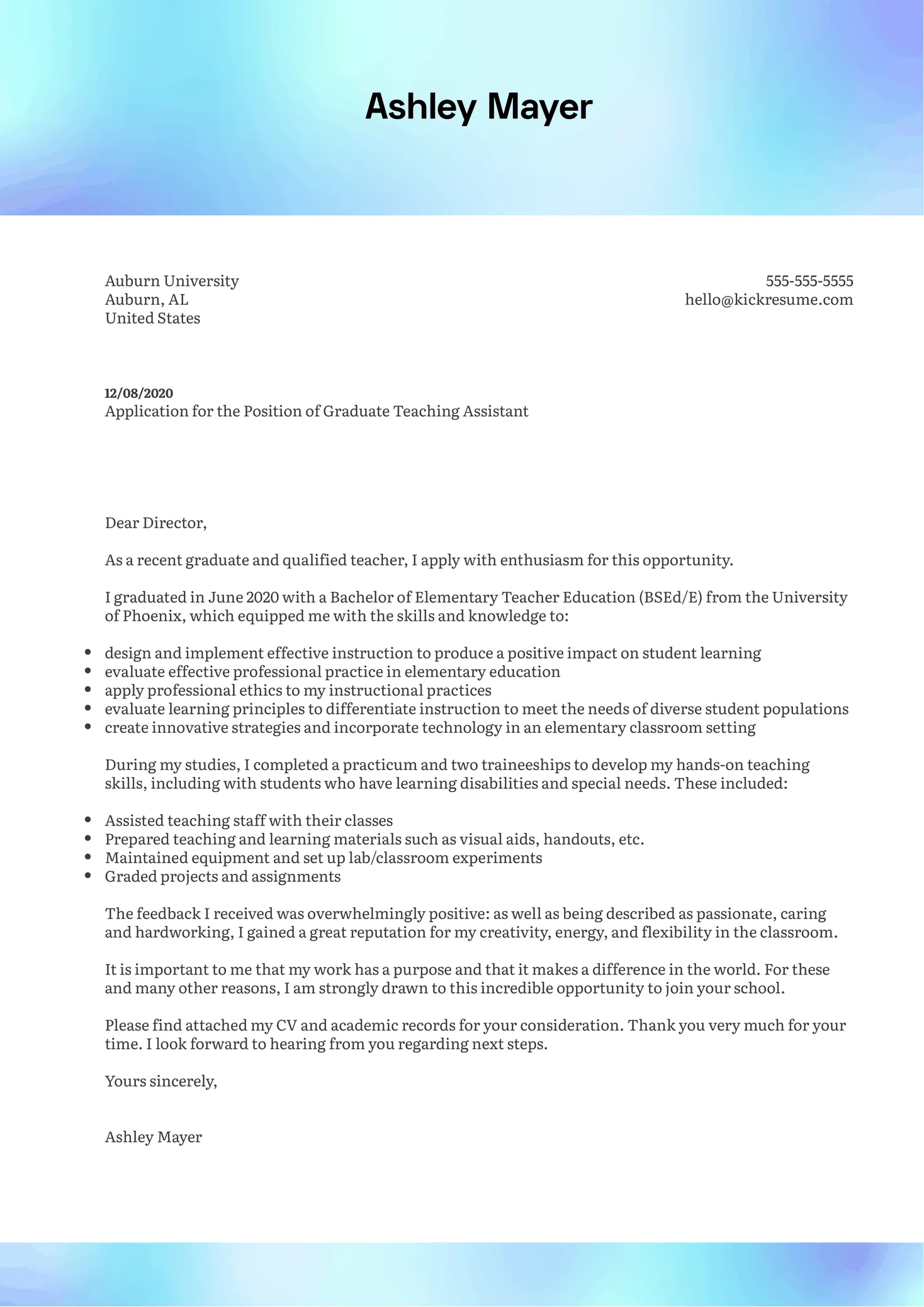
The closing paragraph should summarize your interest in the position and reiterate your qualifications. Express your enthusiasm for the opportunity and state your eagerness to discuss your application further. Thank the hiring manager for their time and consideration. Reiterate your interest in the role and express your desire to learn more. The closing paragraph should leave a positive and lasting impression, emphasizing your professionalism and enthusiasm. Make sure to end the cover letter with a strong call to action, such as an invitation to interview.
Call to Action
Include a call to action in your closing paragraph, encouraging the hiring manager to take the next step. State your availability for an interview. Provide your contact information and express your interest in discussing your application further. Thank the hiring manager for their time and consideration. This shows that you are proactive and genuinely interested in the position. A clear and concise call to action shows your enthusiasm, and makes it easy for the recruiter to move forward with your application.
Proofreading and Editing
Proofreading and editing your cover letter is one of the most important steps in the application process. Even a single typo or grammatical error can undermine your credibility and make a negative impression on the hiring manager. Carefully review your cover letter for any errors in grammar, spelling, punctuation, and formatting. Read it aloud to catch any awkward phrasing or unclear sentences. Ask a friend, professor, or career advisor to review your cover letter and provide feedback. They may catch errors that you have overlooked. Make sure your letter is free from errors and that your writing is clear and concise. (See image proofreading-cover-letter.webp)
